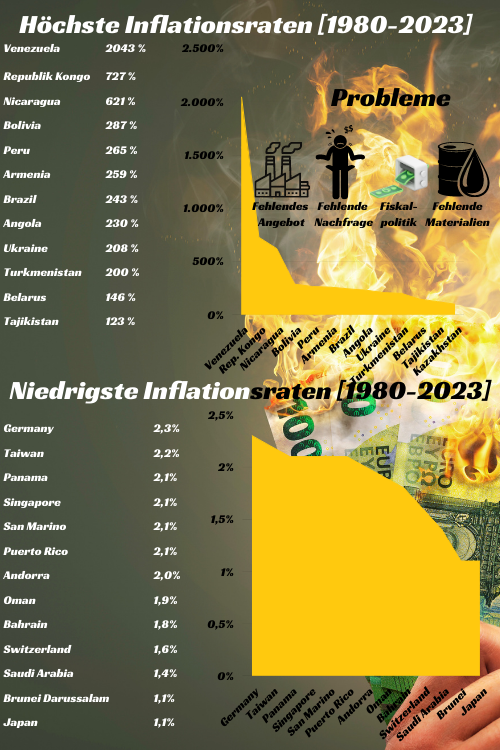Inflation rates around the world exploded in 2022 and 2023. Inflation, i.e. the general increase in prices of goods and services, can have a direct impact on our daily lives. We have all felt this more than clearly when paying at the supermarket, on the electricity bill or at the gas station.
Inflation Worldwide: Highest and Lowest Inflation Rates Worldwide 1980-2028
What you can learn here
- Inflation Worldwide: Highest and Lowest Inflation Rates Worldwide 1980-2028
- Inflation Germany and Europe: Highest and Lowest Inflation Rates in Europe 1980-2028
- Highest and lowest inflation rates in Africa 1980-2028
- Highest and Lowest Inflation Rates in America 1980-2028
- Highest and lowest inflation rates in Asia 1980-2028
- Highest and Lowest Inflation Rates in Oceania 1980-2028
- What happens to a loan in inflation?
For 2023, the IMF expects inflation in Argentina to reach an alarming 99 %. This means that prices will double within one year. High inflation represents a major challenge for the Argentine economy and the population, as purchasing power is declining rapidly.
The picture is similar in Turkey, where inflation will slow somewhat in 2023 but will still be a high 50.5 % year-on-year. This highlights the ongoing difficulties that can accompany inflation in some countries.
But Argentina and Turkey are not the only countries struggling with rising prices. Around the world, many countries are affected by inflation, particularly due to high energy and food prices. In Germany, prices are expected to rise by more than 6 % in 2023 compared with the previous year. In the United States, the IMF forecasts inflation of just under 5 %.
However, there are also exceptions in 2023. China recorded a comparatively moderate price increase of only 0.7 % in March 2023 compared with the same month of the previous year. This shows that it is possible to keep inflation in check if certain economic and political measures are taken.
Inflation rates can change constantly and are influenced by many factors. These include monetary policy, supply and demand, external shocks and political decisions.
A look at inflation rates worldwide illustrates how different the situation can be in different countries. While some struggle with significant price increases, other countries can successfully control inflation. Close analysis of these factors by decision makers can help us understand economic trends and respond appropriately.

Inflation Germany and Europe: Highest and Lowest Inflation Rates in Europe 1980-2028
In Europe, there were significant differences in the inflation rates of the various countries in the period from 1980 to 2023. While some countries shone with stable prices and low inflation, others faced extreme price increases and hyperinflation.
Among the countries with the highest inflation rates in Europe, the experience of some former Eastern bloc countries stands out in particular. In the 1990s, after the collapse of communism, countries such as Russia, Romania and Ukraine experienced very high inflation rates. In some cases, they reached double-digit or even triple-digit percentages. These turbulent economic times were often associated with political and economic upheavals, which led to a rapid rise in prices.
On the other hand, there were also European countries that had remarkably low inflation rates during the period under review. For example, countries such as Germany, the Netherlands and Switzerland have maintained remarkably stable price developments and relatively low inflation rates. These countries have generally developed sound economic fundamentals, good monetary policies and effective mechanisms to control inflation.
Highest and lowest inflation rates in Africa 1980-2028
Inflation rates in Africa from 1980 to 2023 were characterized by significant differences, with some countries facing extremely high inflation rates while others were able to show relatively stable price developments.
| Country | Average inflation rate [1980-2023] | Number of years considered |
|---|---|---|
| Democratic Republic of the Congo | 727,3 | 49 |
| South Sudan | 54,7 | 17 |
| Zimbabwe | 36,9 | 48 |
| Burundi | 9,8 | 49 |
| Lesotho | 8,8 | 49 |
| Botswana | 8,2 | 49 |
| South Africa | 8,2 | 49 |
| Rwanda | 7,6 | 49 |
| Mauritius | 6,9 | 49 |
| Libya | 5,7 | 49 |
| Mauritania | 5,4 | 38 |
| Cameroon | 4,1 | 49 |
| Togo | 3,8 | 49 |
| Côte d'Ivoire | 3,8 | 49 |
| Comoros | 3,6 | 49 |
| Burkina Faso | 3,4 | 49 |
| Djibouti | 2,9 | 37 |
Among the African countries with the highest inflation rates, the Democratic Republic of Congo stands out. In the early 1990s, the country experienced hyperinflation, which led to a drastic devaluation of the currency. Inflation rates reached astronomical levels, eventually reaching a peak that will go down in history. Other countries, such as Zimbabwe, South Sudan and Burundi, also experienced periods of high inflation, which put considerable strain on the economy and people's living conditions.
On the other hand, there were also African countries with comparatively low inflation rates. Countries such as Djibouti, Burkina Faso and Comoros have managed to maintain stable price development and inflation rates on a par with a Western industrialized country. This is the result of sound economic policies, a strong central bank and effective regulation of the monetary and currency system.
Highest and Lowest Inflation Rates in America 1980-2028
The continental Americas experienced significant differences in inflation rates across countries during the period from 1980 to 2023. While some countries scored with stable prices and low inflation, others faced significant inflation fluctuations and economic challenges.
Among the countries with the highest inflation rates in America, the following stands out Venezuela clearly stands out. The country experienced massive hyperinflation in recent years, which led to a rapid devaluation of the currency. Inflation rates reached enormous heights and had a serious impact on the economy and people's daily lives.
Similar to Venezuela, there were other countries in Latin America, including Argentina and Bolivia, that struggled with high inflation rates. In some cases, inflation rates reached double-digit or even triple-digit percentages, leading to significant economic and social challenges.
On the other hand, there were also American countries that performed well in terms of inflation. Countries such as Canada, the United States and Chile have generally maintained stable economic conditions and recorded relatively low inflation rates. These countries have thus managed to implement sound monetary policies and strengthen their economic foundations.
Highest and lowest inflation rates in Asia 1980-2028
Asia, the world's largest continent, has a diverse range of inflation rates that vary significantly from country to country. In the period from 1980 to 2023, some Asian countries experienced both high and low inflation rates, reflecting the different economic and political conditions in the region.
Among the countries with the highest inflation rates in Asia, Armenia, Turkmenistan, and Kazakhstan stand out with averaged triple-digit inflation rates. In recent decades, these countries have been affected by high inflation due to a combination of political instability and a lack of economic diversification. Similar challenges have also been observed in countries such as Pakistan and Indonesia, where high inflation rates have at times led to extreme economic stress.
On the other hand, there are also countries in Asia with comparatively low inflation rates. Japan is a notable example of how the country has managed to maintain a stable price development (average inflation 1980-2023: 1.1 %) despite economic challenges. Singapore and South Korea have also achieved relatively low inflation rates due to their solid economic stability, effective monetary policy and strong regulation.
Highest and Lowest Inflation Rates in Oceania 1980-2028
Oceania, the world's smallest continent, consists of a large number of islands and countries, many of which have small economies with their own inflation rates. In the period from 1980 to 2023, Oceania had both countries with high inflation rates and those with comparatively low rates. Compared to other continents, however, there are no major differences in inflation rates in Oceania from 1980-2023:
| Oceania country | Average inflation rate in percent [1980-2023] | Number of years considered |
|---|---|---|
| Australia | 3,9 | 49 |
| Fiji | 4,1 | 49 |
| Kiribati | 3,0 | 49 |
| Marshall Islands | 2,4 | 25 |
| Micronesia | 2,5 | 33 |
| Nauru | 4,3 | 24 |
| New Zealand | 4,3 | 49 |
| Palau | 2,6 | 28 |
| Papua New Guinea | 6,6 | 49 |
| Samoa | 6,0 | 49 |
| Solomon Islands | 7,7 | 49 |
| Tonga | 5,8 | 49 |
| Tuvalu | 3,3 | 28 |
| Vanuatu | 4,1 | 49 |
Data source for all charts: International Monetary Fund
What happens to a loan in inflation?
In principle, borrowers benefit from inflation. The decrease in the value of money over time reduces the real amount owed. The nominal amount of the loan remains the same, while the purchasing power of money decreases. This facilitates the repayment of the loan, as the debt is "inflated away". However, this does not apply without restriction. Only if wages are adjusted in line with inflation, a borrower also benefits from increased purchasing power.
Problem of lagging wages and salaries
While inflation reduces the value of money, consumer prices often rise faster than wages and salaries. In recent years, incomes in Germany have not risen at the same rate as the cost of living, which has been driven by inflation. This means that many borrowers who are paying off their Housing Loan serviced with their regular income, cannot count on the support of inflation. The debt burden remains high, while income does not increase.
Advantages for investors in real estate
For investors who invest in Real estate investing and the Loan rates covered by rental income, the situation looks different. Often, rents can be adjusted to the likewise rising rent index when a certain adjustment threshold is reached. Thus, rents rise in line with inflation while the loan amount remains unchanged. This can give investors an advantage in times of inflation. In particular, if the lease is linked to the general inflation rate, landlords can relax. The rent is then adjusted to the increased costs on a regular basis.





